今日首先介绍前端技术Apache ECharts,说明后端需要准备的数据,然后讲解具体统计功能的实现,包括营业额统计、用户统计、订单统计、销量排名。
一、ECharts
是什么
ECharts是一款基于 Javascript 的数据可视化图表库。我们用它来展示图表数据。
入门案例
步骤
1). 引入echarts.js 文件
2). 为 ECharts 准备一个设置宽高的 DOM
3). 初始化echarts实例
4). 指定图表的配置项和数据
5). 使用指定的配置项和数据显示图表
代码
js文件在黑马对应项目自取。
测试用的html代码:
<!DOCTYPE html>
<html>
<head>
<meta charset="utf-8" />
<title>ECharts</title>
<!-- 引入刚刚下载的 ECharts 文件 -->
<script src="echarts.js"></script>
</head>
<body>
<!-- 为 ECharts 准备一个定义了宽高的 DOM -->
<div id="main" style="width: 600px;height:400px;"></div>
<script type="text/javascript">
// 基于准备好的dom,初始化echarts实例
var myChart = echarts.init(document.getElementById('main'));
// 指定图表的配置项和数据
var option = {
title: {
text: '班级出勤人数'
},
tooltip: {},
legend: {
data: ['人数']
},
xAxis: {
type: 'category',
data: ['星期1', '星期2', '星期3', '星期4', '星期5']
},
yAxis: {
type: 'value'
},
series: [
{
name: '人数',
type: 'line',
data: [160, 71, 66, 73, 68],
smooth: true
}
]
};
// 使用刚指定的配置项和数据显示图表。
myChart.setOption(option);
</script>
</body>
</html>结果页面如下:
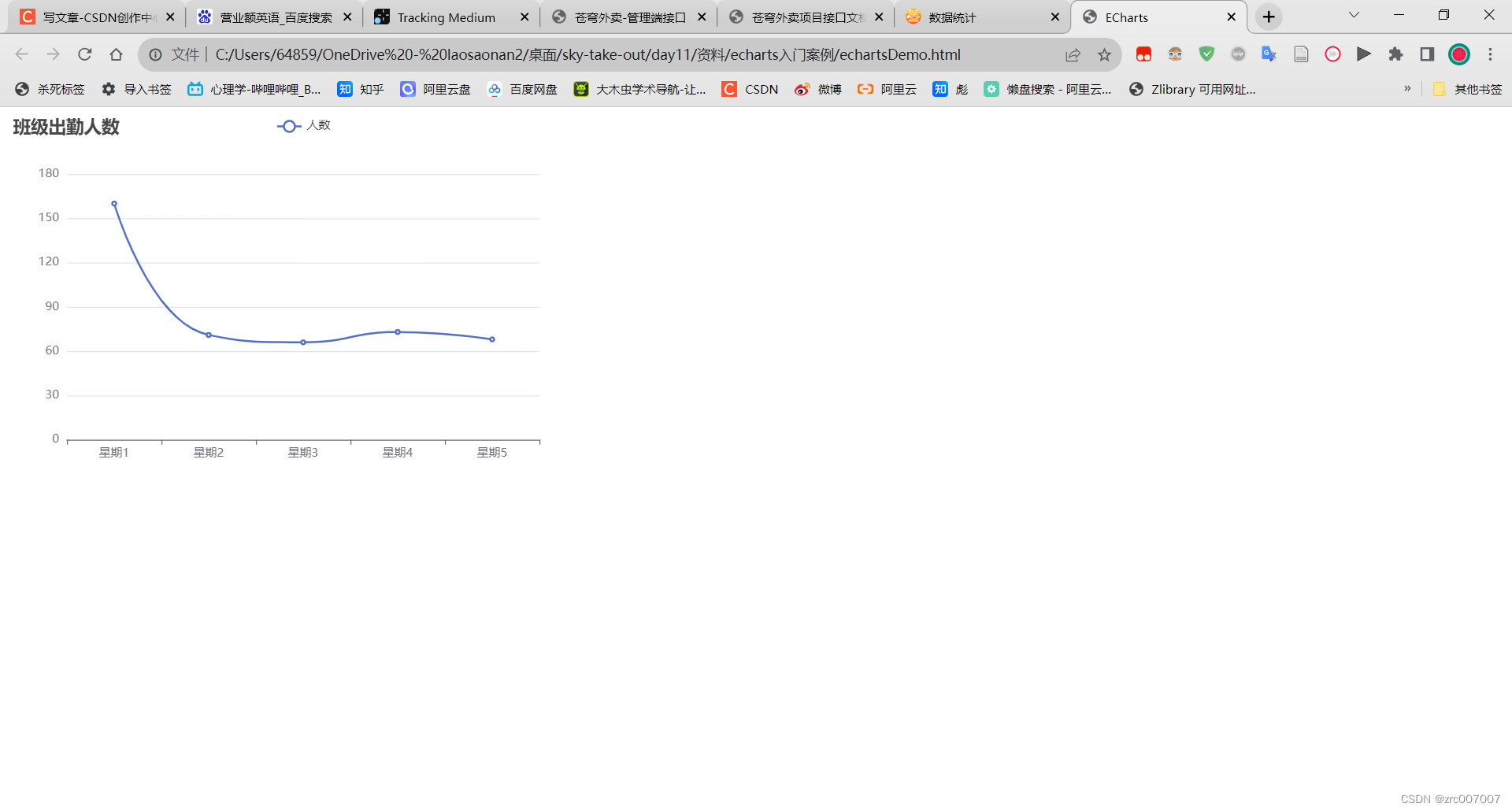
然后我们打开ECharts官网Apache ECharts 选择一个图案来试着改一下。
首先进入官网,点击所有示例。
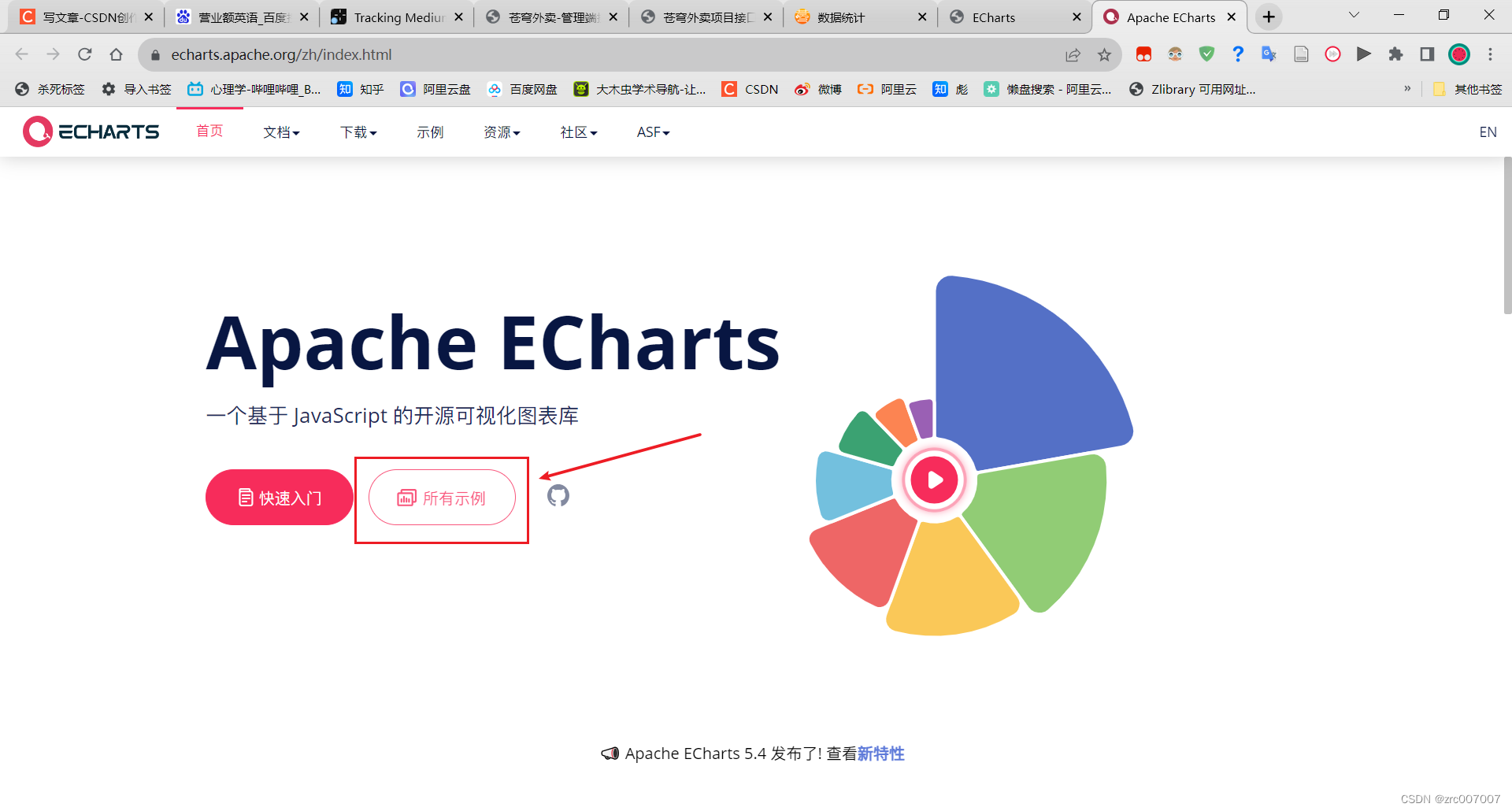
然后点击一个自己喜欢的样式:
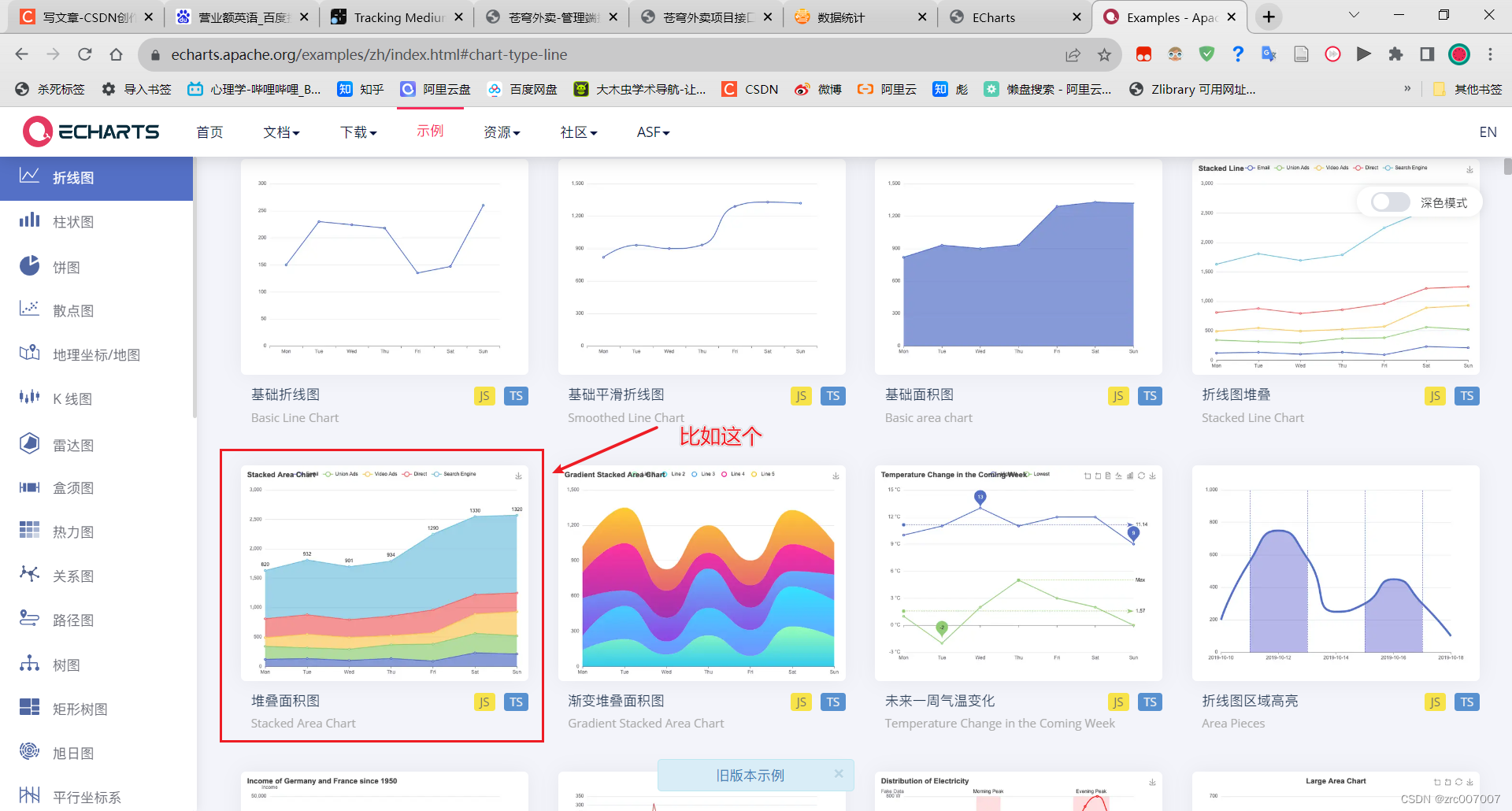
复制左边的代码到原代码的option位置:
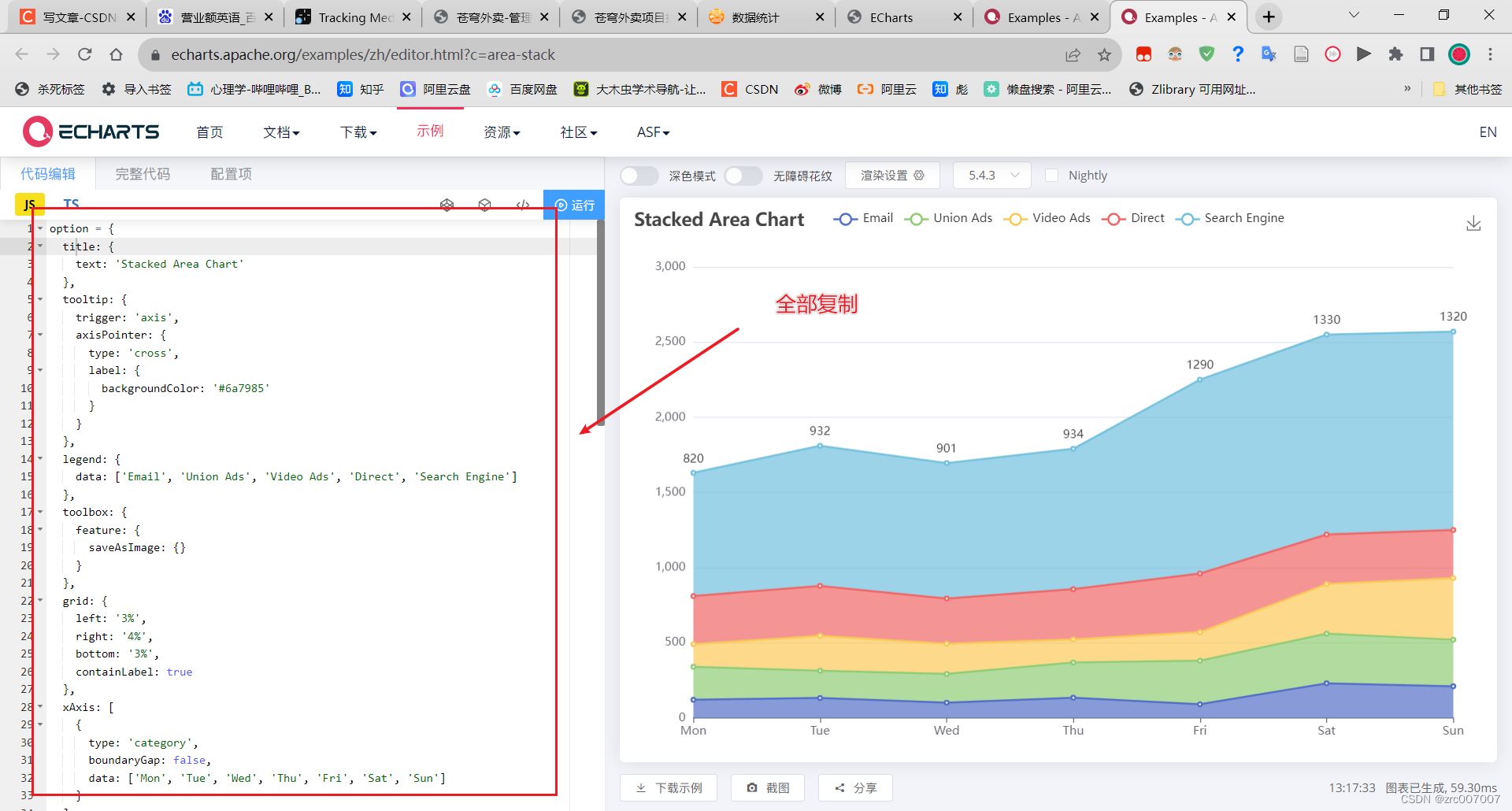
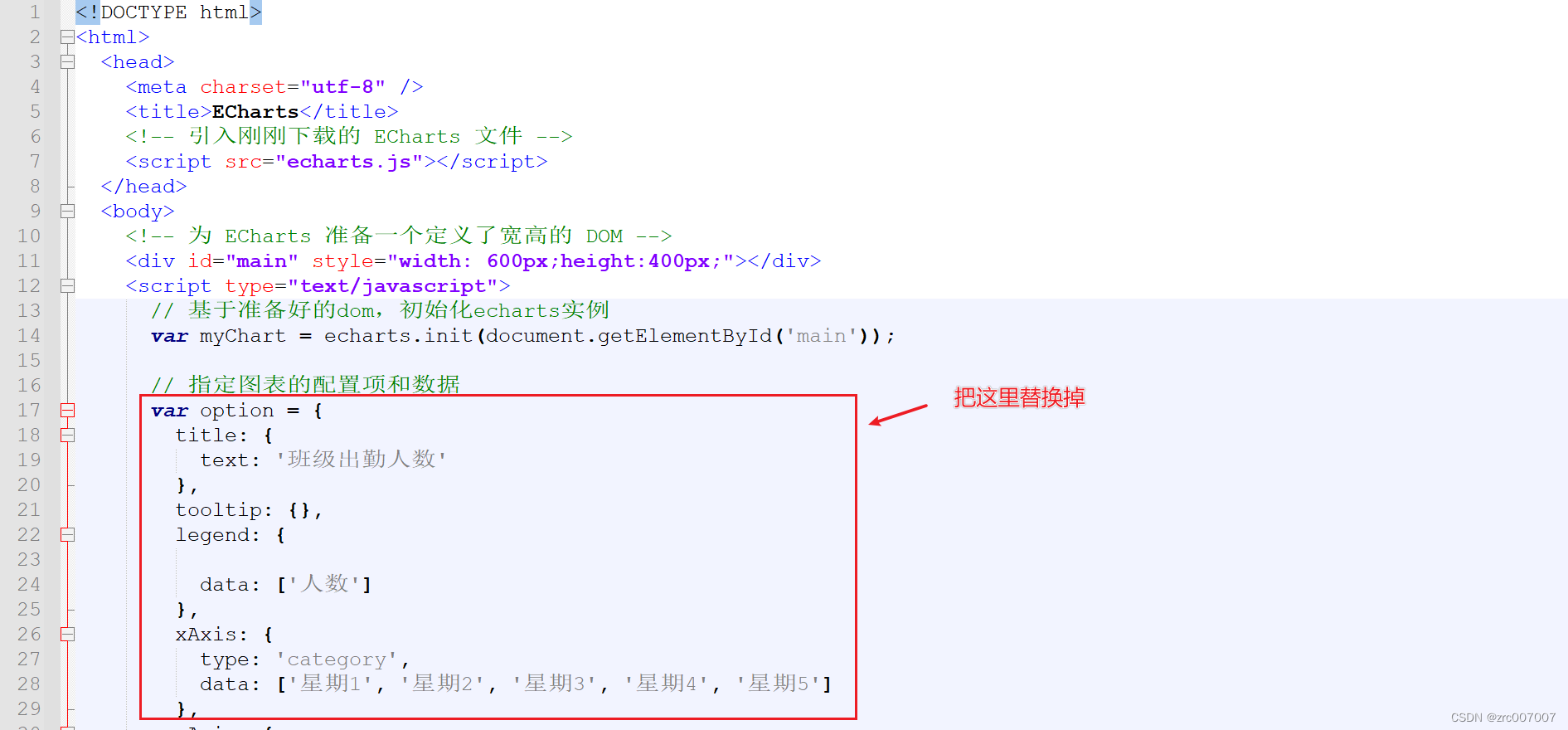
复制后代码如下:
<!DOCTYPE html>
<html>
<head>
<meta charset="utf-8" />
<title>ECharts</title>
<!-- 引入刚刚下载的 ECharts 文件 -->
<script src="echarts.js"></script>
</head>
<body>
<!-- 为 ECharts 准备一个定义了宽高的 DOM -->
<div id="main" style="width: 600px;height:400px;"></div>
<script type="text/javascript">
// 基于准备好的dom,初始化echarts实例
var myChart = echarts.init(document.getElementById('main'));
// 指定图表的配置项和数据
var option = {
title: {
text: 'Stacked Area Chart'
},
tooltip: {
trigger: 'axis',
axisPointer: {
type: 'cross',
label: {
backgroundColor: '#6a7985'
}
}
},
legend: {
data: ['Email', 'Union Ads', 'Video Ads', 'Direct', 'Search Engine']
},
toolbox: {
feature: {
saveAsImage: {}
}
},
grid: {
left: '3%',
right: '4%',
bottom: '3%',
containLabel: true
},
xAxis: [
{
type: 'category',
boundaryGap: false,
data: ['Mon', 'Tue', 'Wed', 'Thu', 'Fri', 'Sat', 'Sun']
}
],
yAxis: [
{
type: 'value'
}
],
series: [
{
name: 'Email',
type: 'line',
stack: 'Total',
areaStyle: {},
emphasis: {
focus: 'series'
},
data: [120, 132, 101, 134, 90, 230, 210]
},
{
name: 'Union Ads',
type: 'line',
stack: 'Total',
areaStyle: {},
emphasis: {
focus: 'series'
},
data: [220, 182, 191, 234, 290, 330, 310]
},
{
name: 'Video Ads',
type: 'line',
stack: 'Total',
areaStyle: {},
emphasis: {
focus: 'series'
},
data: [150, 232, 201, 154, 190, 330, 410]
},
{
name: 'Direct',
type: 'line',
stack: 'Total',
areaStyle: {},
emphasis: {
focus: 'series'
},
data: [320, 332, 301, 334, 390, 330, 320]
},
{
name: 'Search Engine',
type: 'line',
stack: 'Total',
label: {
show: true,
position: 'top'
},
areaStyle: {},
emphasis: {
focus: 'series'
},
data: [820, 932, 901, 934, 1290, 1330, 1320]
}
]
};
// 使用刚指定的配置项和数据显示图表。
myChart.setOption(option);
</script>
</body>
</html>页面展示结果如下:

总结
传输的两列数据,分别是下标和数据。在如下位置:
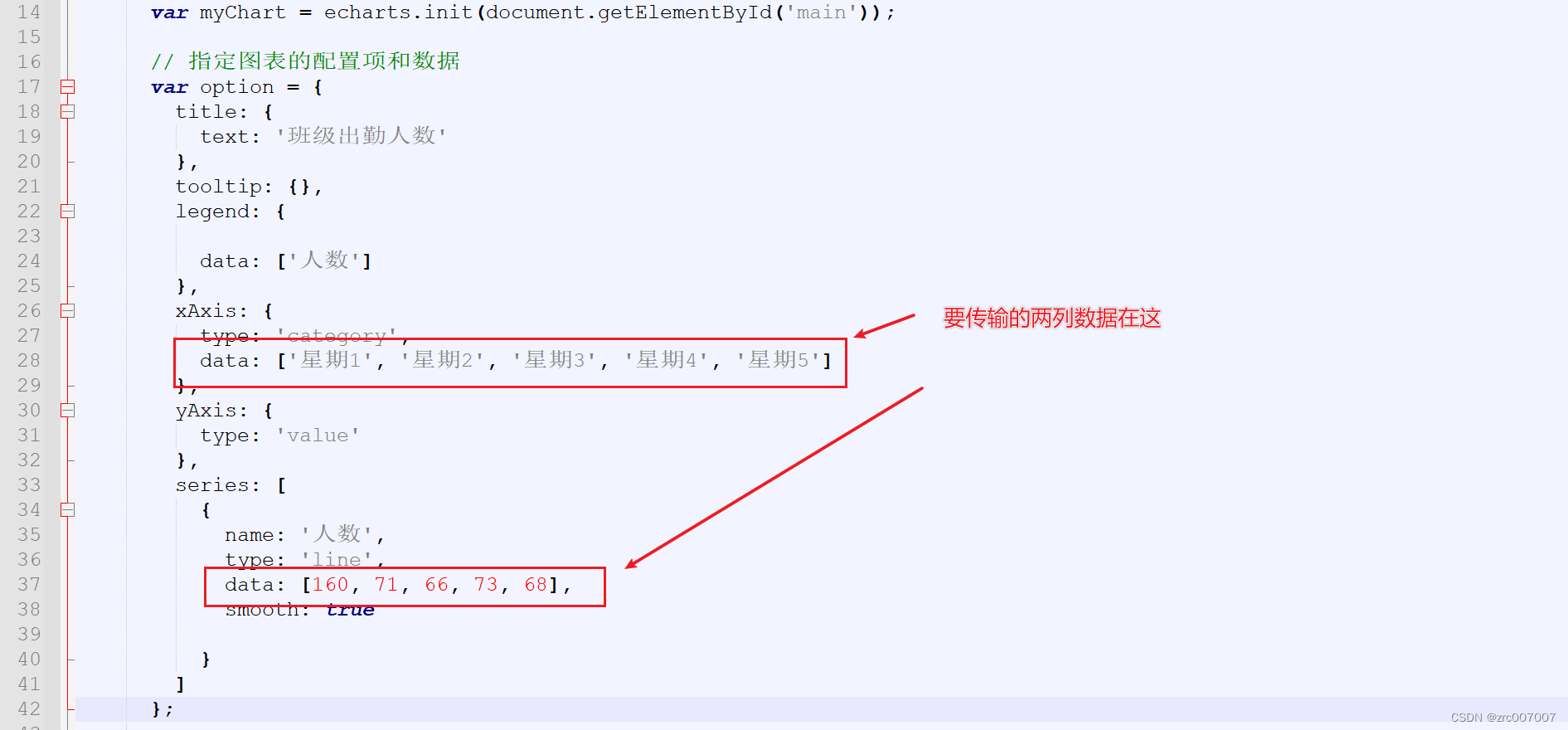
二、营业额统计
查看接口文档

分析
控制层
控制层只要接收数据传给业务层,返回VO(已经有设计好的TurnoverReportVO了)就可以。重点在业务层和持久层。
业务层
具体要处理得到两类,或者说两列数据,包括:
- 日期列表
- 营业额列表
所以步骤便是:
- 获取日期列表
- 获取日期对应的营业额的列表
- 封装返回
持久层
那么持久层需要的操作就在第2步,即:
- 根据日期查找当日营业额
之后几个案例都是大差不差的层次结构,除了数据的种类要求不同。
具体代码
控制层
@RestController
@Slf4j
@Api(tags = "统计相关")
@RequestMapping("/admin/report")
public class ReportController {
@Autowired
private ReportService reportService;
@GetMapping("/turnoverStatistics")
public Result turnoverStatistics(@DateTimeFormat(pattern = "yyyy-MM-dd") LocalDate begin,
@DateTimeFormat(pattern = "yyyy-MM-dd") LocalDate end) {
TurnoverReportVO turnoverReportVO = reportService.turnoverStatistics(begin, end);
return Result.success(turnoverReportVO);
}
}业务层
@Service
public class ReportServiceImpl implements ReportService {
@Autowired
private OrdersMapper ordersMapper;
@Override
public TurnoverReportVO turnoverStatistics(LocalDate begin, LocalDate end) {
// 1. 获取日期列表
List<LocalDate> list = getDateList(begin, end);
// 2. 查询每日营业额
List<Double> result = new ArrayList<>();
Double turnover;
LocalDateTime dayBegin;
LocalDateTime dayEnd;
if (list != null && list.size() > 0) {
dayBegin = LocalDateTime.of(list.get(0), LocalTime.MIN); // 知识点2和3
dayEnd = LocalDateTime.of(list.get(0), LocalTime.MAX); // 知识点2和3
} else {
return new TurnoverReportVO();
}
for (LocalDate localDate : list) {
Map<String, Object> map = new HashMap<>();
map.put("status", Orders.COMPLETED);
map.put("begin", dayBegin);
map.put("end", dayEnd);
turnover = ordersMapper.sumByMap(map); // 知识点4
result.add(turnover == null ? 0 : turnover);
dayBegin = dayBegin.plusDays(1);
dayEnd = dayEnd.plusDays(1);
}
// 3. 返回
TurnoverReportVO turnoverReportVO = new TurnoverReportVO();
turnoverReportVO.setDateList(StringUtils.join(list, ","));
turnoverReportVO.setTurnoverList(StringUtils.join(result, ","));
return turnoverReportVO;
}
private List<LocalDate> getDateList(LocalDate begin, LocalDate end) {
List<LocalDate> list = new ArrayList<>();
while (begin.compareTo(end) <= 0) { // 知识点1
list.add(begin);
begin = begin.plusDays(1);
}
return list;
}
}4个知识点
这里体现了4个知识点:
- 日期之间用compareTo比较
- LocalDate和LocalTime组合成LocalDateTime,用LocalDateTime的of方法
- LocalTime.MIN与LocalTime.MAX
- 用Map封装数据交给mapper查找。
持久层
直接上xml文件了:
elect id="sumByMap" resultType="java.lang.Double">
select sum(amount)
from orders
<where>
<if test="status!=null and status!=''">
status = #{status}
</if>
<if test="begin!=null and end!=null">
and order_time between #{begin} and #{end}
</if>
</where>
</select>三、用户统计
接口文档
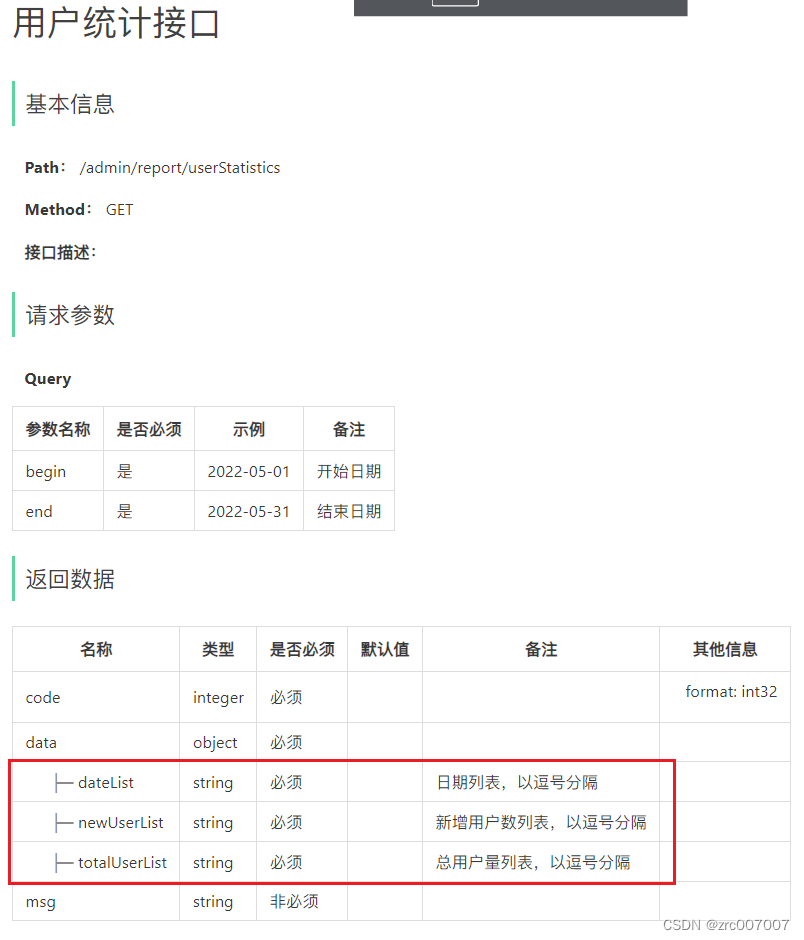
分析所需数据
由于三层的架构都大差不差,所以直接介绍所需数据的不同。
- 日期列表
- 新增用户数列表
- 总用户数列表
具体代码
控制层
@GetMapping("/userStatistics")
public Result userStatistics(@DateTimeFormat(pattern = "yyyy-MM-dd") LocalDate begin,
@DateTimeFormat(pattern = "yyyy-MM-dd") LocalDate end) {
UserReportVO userReportVO = reportService.userStatistics(begin, end);
return Result.success(userReportVO);
}业务层
@Override
public UserReportVO userStatistics(LocalDate begin, LocalDate end) {
// 1. 获取日期列表
List<LocalDate> dateList = getDateList(begin, end);
// 2. 获取用户数量列表
List<Integer> newUserList = new ArrayList<>();
List<Integer> totalUserList = new ArrayList<>();
LocalDateTime dayBegin;
LocalDateTime dayEnd;
if (dateList != null && dateList.size() > 0) {
dayBegin = LocalDateTime.of(dateList.get(0), LocalTime.MIN);
dayEnd = LocalDateTime.of(dateList.get(0), LocalTime.MAX);
} else {
return new UserReportVO();
}
Integer totalUser;
Integer newUser;
for (LocalDate localDate : dateList) {
Map<String, Object> map = new HashMap<>();
map.put("end", dayEnd);
totalUser = userMapper.countByMap(map);
totalUserList.add(totalUser == null ? 0 : totalUser);
map.put("begin", dayBegin);
newUser = userMapper.countByMap(map);
newUserList.add(newUser == null ? 0 : newUser);
dayBegin = dayBegin.plusDays(1);
dayEnd = dayEnd.plusDays(1);
}
// 3. 返回
UserReportVO userReportVO = new UserReportVO();
userReportVO.setDateList(StringUtils.join(dateList, ","));
userReportVO.setNewUserList(StringUtils.join(newUserList, ","));
userReportVO.setTotalUserList(StringUtils.join(totalUserList, ","));
return userReportVO;
}3个注意的点
第一点,获取日期列表可以抽取出来,供营业额统计、用户统计共同调用。
小tips,抽取函数的快捷键是 ctrl + alt + m 哦。
第二点,持久层的两次查找,可以巧妙的用一个函数来完成的。用动态sql的if判断,分为有begin时间的判断和没有begin时间的判断进行处理。具体看下面持久层代码。
第三点,两个统计都要判断持久层查到的结果是不是null,是的话要归为0哦。
持久层
<select id="countByMap" resultType="java.lang.Integer">
select count(*) from user
<where>
<if test="end!=null">
and create_time <= #{end}
</if>
<if test="begin!=null">
and create_time >= #{begin}
</if>
</where>
</select>四、订单统计
接口文档
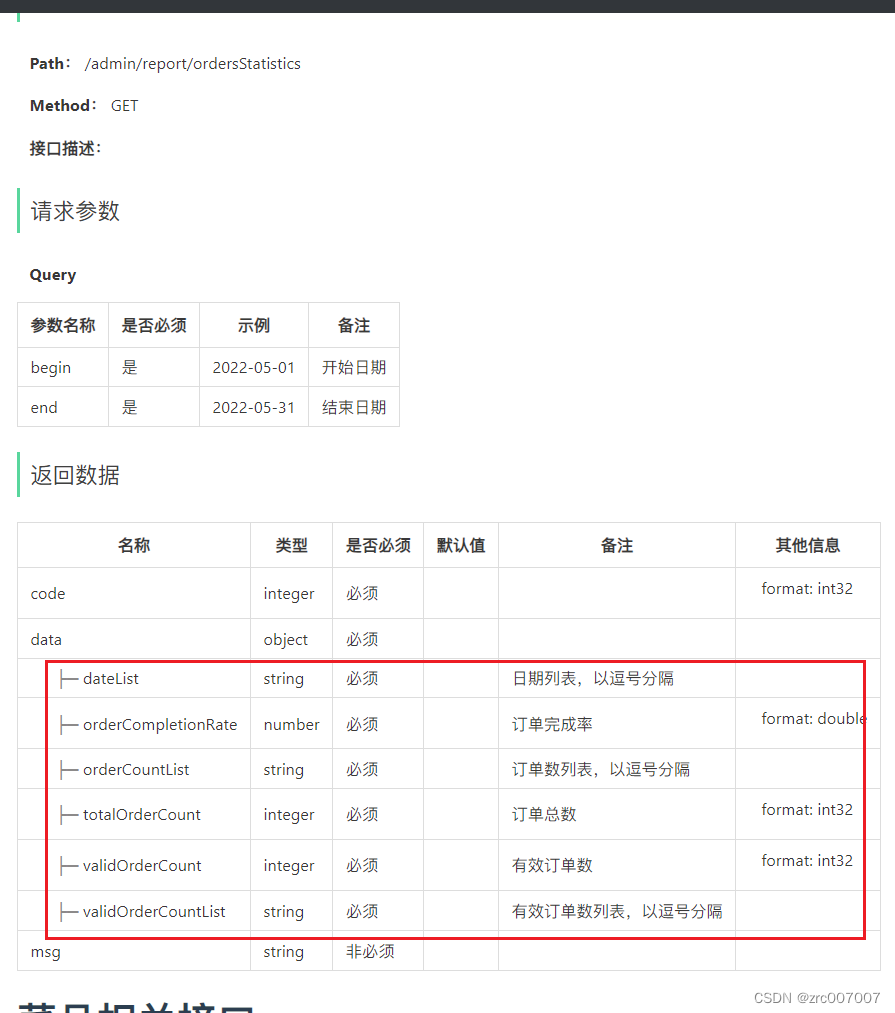
所需数据
- 日期列表
- 所有订单每日总数列表
- 所有订单总数
- 有效订单每日总数列表
- 有效订单总数
- 订单完成率
具体代码
控制层
@GetMapping("/ordersStatistics")
public Result ordersStatistics(@DateTimeFormat(pattern = "yyyy-MM-dd") LocalDate begin,
@DateTimeFormat(pattern = "yyyy-MM-dd") LocalDate end) {
OrderReportVO orderReportVO = reportService.ordersStatistics(begin, end);
return Result.success(orderReportVO);
}业务层
@Override
public OrderReportVO ordersStatistics(LocalDate begin, LocalDate end) {
OrderReportVO orderReportVO = new OrderReportVO();
// 1. 日期列表
List<LocalDate> dateList = getDateList(begin, end);
if (dateList == null) {
return orderReportVO;
}
// 2. 订单数列表
List<Integer> totalOrderList = new ArrayList<>();
// 3. 有效订单数列表
List<Integer> validOrderList = new ArrayList<>();
// 4. 订单总数
Integer totalOrderCount = 0;
// 5. 有效订单总数
Integer validOrderCount = 0;
for (LocalDate localDate : dateList) {
Map map = new HashMap();
map.put("begin", LocalDateTime.of(localDate, LocalTime.MIN));
map.put("end", LocalDateTime.of(localDate, LocalTime.MAX));
Integer total = ordersMapper.countByMap(map);
total = total == null ? 0 : total;
map.put("status", Orders.COMPLETED);
Integer valid = ordersMapper.countByMap(map);
valid = valid == null ? 0 : valid;
totalOrderList.add(total);
validOrderList.add(valid);
totalOrderCount += total;
validOrderCount += valid;
}
// 6. 订单完成率
Double completionR = 0.0;
if (totalOrderCount != null) {
completionR = validOrderCount * 1.0 / totalOrderCount;
}
orderReportVO.setDateList(StringUtils.join(dateList, ","));
orderReportVO.setOrderCountList(StringUtils.join(totalOrderList, ","));
orderReportVO.setValidOrderCountList(StringUtils.join(validOrderList, ","));
orderReportVO.setTotalOrderCount(totalOrderCount);
orderReportVO.setValidOrderCount(validOrderCount);
orderReportVO.setOrderCompletionRate(completionR);
return orderReportVO;
}1个注意的巩固知识点
还是用动态sql来巧妙的满足一个函数查询两种不同的数据,即status的if判断是否查询。
持久层
<select id="countByMap" resultType="java.lang.Integer">
select count(id) from orders
<where>
<if test="status != null">
and status = #{status}
</if>
<if test="begin != null">
and order_time >= #{begin}
</if>
<if test="end != null">
and order_time <= #{end}
</if>
</where>
</select>没啥好说的,算一个巩固练习。
五、销量排名top10
接口文档
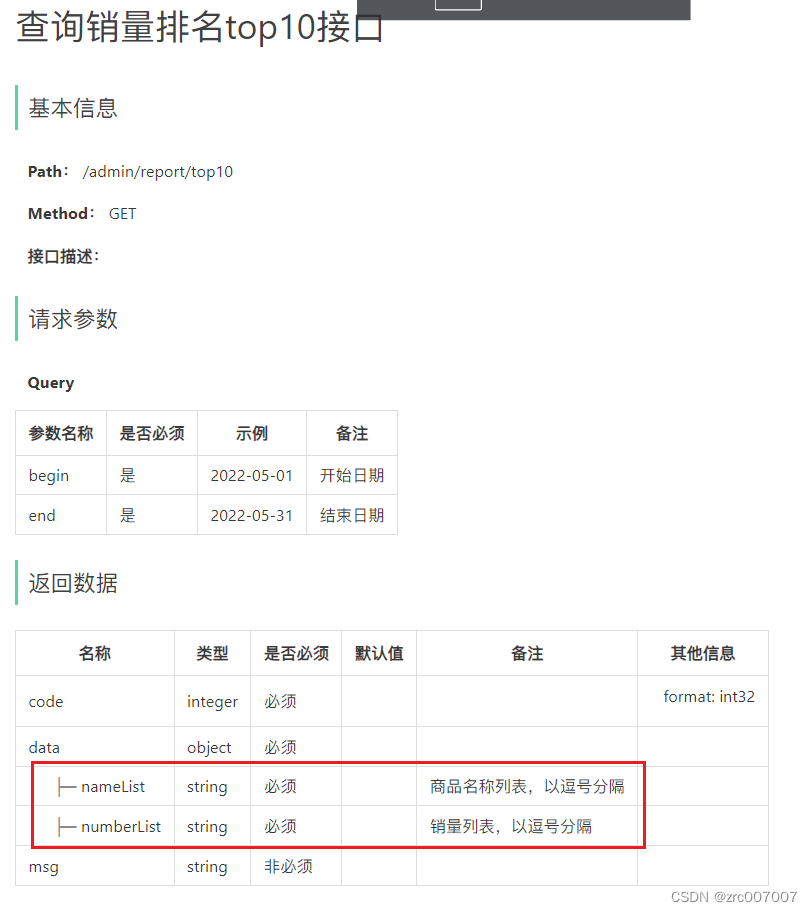
所需数据
- 商品名列表
- 销量列表
具体代码
控制层
@GetMapping("/top10")
public Result top10(@DateTimeFormat(pattern = "yyyy-MM-dd") LocalDate begin,
@DateTimeFormat(pattern = "yyyy-MM-dd") LocalDate end) {
SalesTop10ReportVO salesTop10ReportVO = reportService.top10(begin, end);
return Result.success(salesTop10ReportVO);
}业务层
@Override
public SalesTop10ReportVO top10(LocalDate begin, LocalDate end) {
List<GoodsSalesDTO> goodsSalesDTOS = ordersMapper.countSaleTop10(LocalDateTime.of(begin, LocalTime.MIN), LocalDateTime.of(end, LocalTime.MAX));
if (goodsSalesDTOS == null) {
return new SalesTop10ReportVO();
}
List<String> nameList = new ArrayList<>();
List<Integer> numberList = new ArrayList<>();
for (GoodsSalesDTO goodsSalesDTO : goodsSalesDTOS) {
nameList.add(goodsSalesDTO.getName());
numberList.add(goodsSalesDTO.getNumber());
} // 思考:这里可不可以简写?
SalesTop10ReportVO salesTop10ReportVO = new SalesTop10ReportVO();
salesTop10ReportVO.setNameList(StringUtils.join(nameList, ","));
salesTop10ReportVO.setNumberList(StringUtils.join(numberList, ","));
return salesTop10ReportVO;
}2个注意的点
第一个,下面持久层的多表查询。
第二个,查询到DTO后,对象数据到两列数据的转换。
- 法一,普通方法,老老实实用两个List添加。
- 法二,流方法。值得练习,公司中可能会见到、用到很多,资深程序员必备。
练习:用流的写法完成查询数据到两个列表数据的转换
尝试用流的写法完成。
答案如下:
@Override
public SalesTop10ReportVO top10(LocalDate begin, LocalDate end) {
List<GoodsSalesDTO> goodsSalesDTOS = ordersMapper.countSaleTop10(LocalDateTime.of(begin, LocalTime.MIN), LocalDateTime.of(end, LocalTime.MAX));
if (goodsSalesDTOS == null) {
return new SalesTop10ReportVO();
}
// List<String> nameList = new ArrayList<>();
// List<Integer> numberList = new ArrayList<>();
// for (GoodsSalesDTO goodsSalesDTO : goodsSalesDTOS) {
// nameList.add(goodsSalesDTO.getName());
// numberList.add(goodsSalesDTO.getNumber());
// }
// ==========注意这里的写法==========
List<String> nameList = goodsSalesDTOS.stream().map(GoodsSalesDTO::getName).collect(Collectors.toList());
List<Integer> numberList = goodsSalesDTOS.stream().map(GoodsSalesDTO::getNumber).collect(Collectors.toList());
// ==========注意上面的写法==========
SalesTop10ReportVO salesTop10ReportVO = new SalesTop10ReportVO();
salesTop10ReportVO.setNameList(StringUtils.join(nameList, ","));
salesTop10ReportVO.setNumberList(StringUtils.join(numberList, ","));
return salesTop10ReportVO;
}持久层
<select id="countSaleTop10" resultType="com.sky.dto.GoodsSalesDTO">
select t2.name, sum(t2.number) as number
from orders as t1
inner join order_detail as t2
on t1.id = t2.order_id
where t1.status = 5
and t1.order_time >= #{begin}
and t1.order_time <= #{end}
group by t2.name
order by number desc limit 0, 10;
</select>复习
1.ECharts最少需要准备几列数据?
2.LocalDateTime的比较,以及比较接口讲解的复习
3.日期时间的拼接、时间在一天的最大、最小值
4.Map封装数据进行查找的代码手法
5.统计中,持久层查询为null的归0化处理;
6.查找增量与总量时的简写mapper查询。